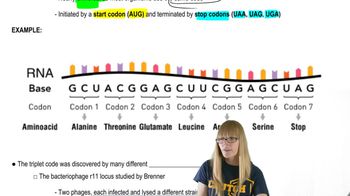Here are the essential concepts you must grasp in order to answer the question correctly.
Tetranucleotide Structure
A tetranucleotide consists of four nucleotides in a specific sequence. In the context of mRNA, the sequence of nucleotides determines the codons, which are groups of three nucleotides that code for specific amino acids. The arrangement of these nucleotides affects how many unique codons can be formed, influencing the number of amino acids incorporated during protein synthesis.
Recommended video:
Codon Usage
Codons are sequences of three nucleotides in mRNA that correspond to specific amino acids during translation. The genetic code is degenerate, meaning that multiple codons can code for the same amino acid. The difference in the number of amino acids incorporated from the two mRNA sequences (UUAC vs. UAUC) is due to the variation in codon combinations that can be formed from the respective tetranucleotides.
Recommended video:
Amino Acid Incorporation
The process of incorporating amino acids into a growing polypeptide chain during translation is dictated by the mRNA sequence. Each unique codon corresponds to a specific amino acid, and the total number of distinct codons determines how many different amino acids can be added. In this case, the tetranucleotide UUAC produces fewer unique codons than UAUC, leading to the incorporation of fewer amino acids.
Recommended video:
 Verified step by step guidance
Verified step by step guidance

